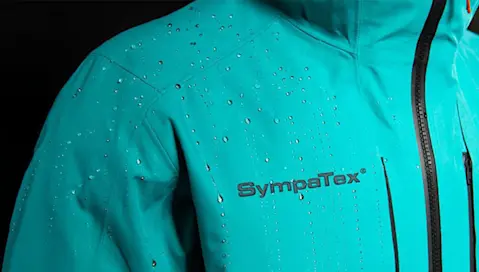Sympatex’s Circular Production Strategy Starts With Aptean Apparel ERP rs2 Edition
Sympatex’s Circular Production Strategy Starts With Aptean Apparel ERP rs2 Edition
Sympatex’s Circular Production Strategy Starts With Aptean Apparel ERP rs2 Edition
13 Aug 2025
Aptean Staff Writer
“On the surface, we are producing functional textiles for the outdoor industry, contract and workwear. Underneath, we're an activist trying to turn the apparel industry into circular mode.”
This is how Rüdiger Fox, CEO and “chief environmental activist” at Sympatex, summed up his company’s mission for manufacturing performance fabrics.
By 2030, Sympatex aims to produce all its garments in a 100% circular fashion. To enable this, the company must be able to track its materials through design, sourcing, use, reuse and recycling, creating closed-loop processes where textiles flow through multiple lifecycles without waste.
But this level of material traceability and environmental transparency requires tailored tools powering end-to-end, real-time visibility. That’s why Sympatex has replaced its legacy enterprise resource planning (ERP) system with a solution specialized for the apparel industry, Aptean Apparel ERP rs2 Edition.

Old Systems Blocked Sympatex’s Path to Sustainable Production
Sympatex manufactures textiles using a polyester-based plastic with a wind- and waterproof membrane. The material combines durability and breathability—and crucially, it can be recycled as easily as a PET bottle.
But being an eco-friendly company demands more than just using recyclable materials. It requires precise data: the ability to trace every component through a complex global supply chain, calculate the exact climate footprint of each product and deliver sustainability reports that can withstand regulatory and public scrutiny.
For Sympatex, becoming a circular clothing brand was impossible with a 30-year-old ERP system.
“When I came to the company about eight years ago, we were operating in about 30 years of data mess,” said Fox. “There were tons of data, but it was not really usefully structured, so we couldn’t generate intelligent reporting.”

Building the Digital Infrastructure for Closed-Loop Manufacturing
Sympatex’s mission to bring full transparency to its operations and deliver closed-loop manufacturing processes drove a rigorous search for a new ERP system.
The company evaluated 45 potential vendors over three rounds of evaluation and comparison. Teams from across the business participated to ensure the chosen system could meet both operational demands and sustainability goals.
“We decided to use Aptean Apparel ERP rs2 Edition after a pretty exhaustive bidding process,” Fox recalled.

Aptean’s apparel ERP gave Sympatex the tools to standardize its data for precise sustainability tracking without losing the flexibility needed to keep innovating.
“I would even say it forced us into that level of standardization which wasn’t previously possible before,” Fox noted.
Zero-Downtime ERP Implementation
While moving to industry-specific software was essential for Sympatex’s sustainability strategy, pausing operations to deploy the new ERP wasn’t an option.
The company needed to replace its core system without disrupting production or delivery schedules—a task that required precision and partnership. “It’s almost like open heart surgery. We needed to change the ERP system without stopping the company, not even for six hours,” Fox explained.
The key, he said, was expert support. “Having a team of partners that can accompany you in the transition process, especially in those critical moments, so they are well prepared when you really do the switch over,” he elaborated.
The apparel ERP rollout proved remarkably smooth, and Fox was impressed by the speed with which the Sympatex team embraced the new system. Ultimately, he credits the success of the implementation not just to the technology, but to the people behind it.
“The No. 1 advantage beside the system is probably the human interface we found and the mutual understanding we could build in making this work,” Fox shared. “Training wasn’t that complex, and when we kicked off, within days everybody was working well in that new environment.”

Aptean Apparel ERP rs2 Edition: The Engine Powering Visible Change
For Sympatex, moving to Aptean Apparel ERP rs2 Edition increased the company’s operating efficiency, not to mention its ability to measure, report and act on its circular production strategy.
With the new ERP system in place, the company can now:
Keep pace with evolving EU sustainability requirements. Aptean’s apparel ERP software provides the data integrity and reporting flexibility needed to meet the European Commission’s growing demands for environmental accountability.
Generate meaningful product-level environmental data. Sympatex can integrate external databases with its ERP system to produce accurate corporate social responsibility (CSR) reports, giving customers visibility into the climate footprint of each product.
“We are very committed to building up CSR reporting much faster than anybody else in the industry; that was one of the main motivation factors for the system,” Fox explained. “You can plug in other databases to get out not only quantities or numbers, but actual footprints, which we will soon provide to every customer of ours on each delivery.”
Manage the complexity of sustainable textile manufacturing. Aptean Apparel ERP rs2 Edition meets the unique demands of Sympatex’s functional textile production. For example, it can track materials by meters as well as by pieces. The system allows Sympatex to work flexibly while keeping business processes aligned to clear standards. “The system allows flexibility, which you really need, and at the same time, forces the organization to stay in a pretty much standard approach to the business processes,” Fox said.
Connect seamlessly with supply chain partners. The system’s architecture enables collaboration across the value chain through shared data and transparency.
“That's the efficiency payoff. Everybody who works with the system gets more efficient by getting the right answers and fast,” Fox shared.
For Fox, the true success of the new ERP system lies in its quiet, consistent reliability.
“The less I hear about the ERP system, the better it is. And I hear almost nothing. It’s functioning in the background as a reliable backbone to the organization,” he said.

Sympatex Sets the Standard for Circular Textile Production
Sympatex sees its current ERP capabilities as just the beginning in its drive toward circular textile manufacturing. For Fox, artificial intelligence (AI) is the next step in turning sustainability data into an everyday tool.
"The whole idea is to have, at some point in the tangible future, a system where I can ask questions without programming any reporting. I can just have AI give me intelligent answers. I think that's extremely attractive," Fox elaborated.
With Aptean Apparel ERP rs2 Edition as its digital backbone, the company has moved from grappling with legacy data to building accountability into every part of its operations, embedding sustainability throughout its textile production processes.
For others in the textile industry, Sympatex’s journey shows what’s possible when purpose and technology align. A strong digital infrastructure doesn’t just support environmental responsibility; it measures progress and ensures lasting impact.
The future of circular textile production will belong to those brands who can prove their climate credentials. Sympatex is already setting the standard.
Ready to accelerate your sustainability program? Request a personalized ERP demo to see how Aptean’s apparel software can track and improve your climate credentials.



